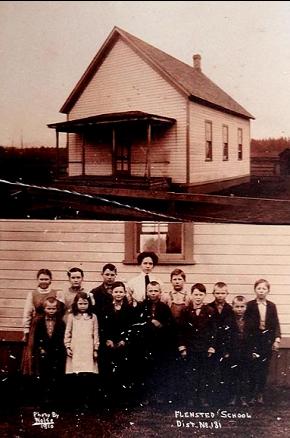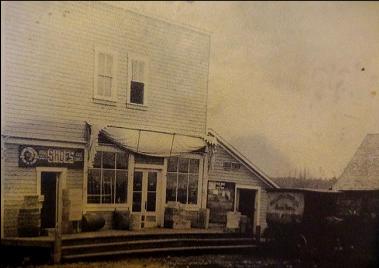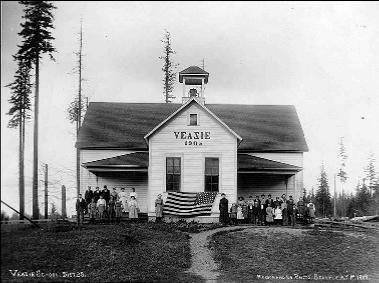Early Enumclaw Neighbors (continued)
About
Contact
Flensted
The first Danes settled in the Enumclaw area in the mid-1880s near the Mahler homestead. Sarne and Kris Sorensen and Julius and Louis Nicholas bought land with their railroad wages and then sent to Denmark for family and friends. Before long, the Danes had started many farms in the area.
It was a struggle to survive, especially with the Depression of the 90s. Hard times were compounded first with the collapse of the hop market and then an infestation of hop lice. Sorensen survived by turning to pottery as a trade, a skill he had learned in Denmark. On the bottom of each pot, he stamped Flensted, his native Danish town, and gave this name to the young community.1 (It was located about where the current Evergreen Cemetery is and should not to be confused with the current Flensted housing development on the south end of town.)
The Sorensens had to buy on credit at the store, and eventually got so behind they were forced to mortgage the farm. In time, however, they recovered, and later Sarne became a very successful businessman in Enumclaw. According to his nephew, Herb, Sarne would have remained a potter all his life had he not left Denmark for Enumclaw.
The first Danes settled in the Enumclaw area in the mid-1880s near the Mahler homestead. Sarne and Kris Sorensen and Julius and Louis Nicholas bought land with their railroad wages and then sent to Denmark for family and friends. Before long, the Danes had started many farms in the area.
It was a struggle to survive, especially with the Depression of the 90s. Hard times were compounded first with the collapse of the hop market and then an infestation of hop lice. Sorensen survived by turning to pottery as a trade, a skill he had learned in Denmark. On the bottom of each pot, he stamped Flensted, his native Danish town, and gave this name to the young community.1 (It was located about where the current Evergreen Cemetery is and should not to be confused with the current Flensted housing development on the south end of town.)
The Sorensens had to buy on credit at the store, and eventually got so behind they were forced to mortgage the farm. In time, however, they recovered, and later Sarne became a very successful businessman in Enumclaw. According to his nephew, Herb, Sarne would have remained a potter all his life had he not left Denmark for Enumclaw.

The Danes supported each other in the hard times by developing cooperatives. They were instrumental in the organization of Farmers' Mutual Insurance Company (now Mutual of Enumclaw) in 1898, the Cooperative Creamery (now Darigold) in 1899, Rochdale Department Store in 1905, and the Enumclaw Grange in 1909.3
Krain
Known today for the Krain Corner Restaurant, this community had its beginnings in 1881. Mathias Malnerich, a native of the Dukedom of Krain in Austria (now Slovenia), bought 320 acres to start a farm. It was difficult in an area of old-growth forest and no roads, bridges, or railroads. He built a house, drained a lake, and eventually planted hay, vegetables, and the big money- maker of the area, hops. Soon after Malnerich's arrival, his cousin came. Word spread among those in his original Austrian parish, so that by 1889, twenty of his home-country neighbors lived in the Washington Krain.
Krain
Known today for the Krain Corner Restaurant, this community had its beginnings in 1881. Mathias Malnerich, a native of the Dukedom of Krain in Austria (now Slovenia), bought 320 acres to start a farm. It was difficult in an area of old-growth forest and no roads, bridges, or railroads. He built a house, drained a lake, and eventually planted hay, vegetables, and the big money- maker of the area, hops. Soon after Malnerich's arrival, his cousin came. Word spread among those in his original Austrian parish, so that by 1889, twenty of his home-country neighbors lived in the Washington Krain.
Flensted School

By this time, there were also fifteen Irish families in the area and the two ethnic groups worked together to build a Catholic church. Mathias Malnerich donated five acres for the church and cemetery and the community raised $625. They bought the materials and paid Anton Kauka $200 to build the 24- by 50-foot structure, complete with a 57-foot high tower .1
Creating productive farms out of old-growth forest was difficult, but some of the Krain residents had been miners in the old country and were able to bring needed cash into the community by working in nearby Franklin and Coal Creek. Others found livelihoods selling their garden vegetables to the miners and their families.
Creating productive farms out of old-growth forest was difficult, but some of the Krain residents had been miners in the old country and were able to bring needed cash into the community by working in nearby Franklin and Coal Creek. Others found livelihoods selling their garden vegetables to the miners and their families.
The Krain Store opened in 1903. It became the Krain Tavern in 1916 and was later rolled across the highway. It housed several other businesses before becoming the Krain Corner Restaurant. A visit there now greets you with rooms full of pictures and stories from the early days of this Slovenian settlement.
Coal Creek/Birch and Veazie
Coal Creek, which later became Birch and Veazie, was first settled by Otto and Theodore Tamm in 1883. As others in neighboring districts had done, they took up claims earlier pioneers had abandoned. In the beginning, they sold vegetables to the miners, and later to crews building the Northern Pacific Railroad. As their farms got larger and they added hops and cattle, the two made a great deal of money in the good years.
Coal Creek/Birch and Veazie
Coal Creek, which later became Birch and Veazie, was first settled by Otto and Theodore Tamm in 1883. As others in neighboring districts had done, they took up claims earlier pioneers had abandoned. In the beginning, they sold vegetables to the miners, and later to crews building the Northern Pacific Railroad. As their farms got larger and they added hops and cattle, the two made a great deal of money in the good years.
The Krain Store
When bad times came, they did better than their peers who had not diversified. They would have done better yet had the railroad built the hoped-for siding in Birch rather than Enumclaw. By 1900, the community, with its post office, hotel and store gone, had only the school remaining. It closed in 1914. Otto Tamm, however, continued to thrive. He worked with a few others to found the cooperatives, and was later president of Mutual of Enumclaw for nineteen years.
Veazie, a few miles out past Birch, was unique in that it was logged before it was settled in 1886. A post office opened in 1890 and closed two years later.1 Veazie struggled to grow, but by the time a new coal vein was discovered there in 1907, the community had only a sawmill, stone quarry, and the mine.2
Veazie, a few miles out past Birch, was unique in that it was logged before it was settled in 1886. A post office opened in 1890 and closed two years later.1 Veazie struggled to grow, but by the time a new coal vein was discovered there in 1907, the community had only a sawmill, stone quarry, and the mine.2

The Veazie School
Mud Mountain/Mt Baldy
The early settlers of the Mud Mountain district arrived by train. In 1888, the Buchanan family were first. Maude, one of the daughters, later described her first day on the claim. "Father had built a split cedar shack to live in until we could haul lumber from Conner's mill and build a house. . . As we walked along the narrow, rough road, mother carried the baby and father carried Belle on his shoulder. Belle from her exalted position saw our new house first. I think she was a bit surprised to see anything but trees, so she pointed her finger and exclaimed, 'Oh, Pa, nares a barn.' "1
Shortly thereafter, George Forler arrived in Enumclaw with his family after crossing the new White River trestle on a freight train, spending the night in the Stevenson hotel. Here is a description by a family member of their going out to the claim for the first time:
"Someone took our things on a pack horse, and we followed the horse. It was only a rough and narrow trail. Very rough. . . Our little cabin was built of split cedar. You could reach out of either of the two windows and touch the trees. . . All our furniture was made out of split cedar. For a mattress, we had a straw tick, minus the straw. The first two years we had dried ferns."2
Soon a third family, the Malidores, joined the Mud Mountain community. Mrs. Malidore described their nighttime arrival at the Stevenson hotel: "Naturally, we did not see much of the town that night and were surprised next morning to see only a few buildings scattered among the trees. . . The three buildings faced Railroad Street, which wasn't a street at all, only a trail through the woods. In fact, there weren't any streets, just trails. . . There was only a foot trail through the woods [to Mud Mountain], some places so muddy one could hardly get through and my husband had to carry me on his back to the place where our home was to be."3
The Moeller family settled nearby in the hills above where the current transfer station is located. With nine children, they had almost enough for a school of their own. All but the baby hiked the long trek through the woods to Mud Mountain. The last one, Arthur, was born in their potato patch to the surprised and hard-working Mrs. Moeller.4
As transportation improved after the turn of the century, the need for so many towns on the Plateau decreased. Better roads, automobiles, and school busses all led to consolidation of services. Enumclaw emerged as the hub of the area, with its critical railroad siding and train station, fast-growing timber company, and administrative center for the economic cooperatives. People still lived and farmed across the Plateau, but the scattered settlements lost much of their individual identities.
=============================
Boise Creek NOTES
1. Boise Beginnings. Historylink.org.
2. Houston Allen interview. Washington Rural Heritage Collections. 9.10.1975. p. 13.
3. Houston Allen interview. Washington Rural Heritage Collections. 9.10.1975. p. 13.
4. Special Edition Supplement to the Enumclaw Courier-Herald/Buckley News Banner. Enumclaw Courier-Herald Centennial Edition, 1985.
Porterville/Osceola NOTES
1. The Osceola Loop Heritage Corridor follows some of these roads today. King County Roads.
2. Mile by mile tour of the Osceola Loop Heritage Corridor, with a 1937 picture of two members of the Jokumsen family and their Osceola Pickle Company truck. King County Roads.
The French District/ Firgrove NOTES
1. Nancy Irene Hall. In the Shadow of the Mountain. The Courier Publishing, Enumclaw, 1983, and republished by Heritage Quest Press, Orting, 2004. p. 26.
2. Nancy Irene Hall. In the Shadow of the Mountain. The Courier Publishing, Enumclaw, 1983, and republished by Heritage Quest Press, Orting, 2004. p. 36.
Flensted NOTES
1. Pioneer History of Enumclaw. Enumclaw Women's Progressive Club, 1938. p. 17.
2. Poppleton, There Is Only One Enumclaw. 1995. p. 93.
3. "Enumclaw Thumbnail". Historylink.org.
Krain NOTES
1. "History of the Slovenian Community and Church in Krain, WA". Slovenes in the USA
A list of those buried at the "Holy Family Krain Cemetery". US Cemetery Project.
Coal Creek/Birch and Veazie NOTES
1. Poppleton, There Is Only One Enumclaw. 1995. pp. 97-98.
2. Nancy Irene Hall. In the Shadow of the Mountain. The Courier Publishing, Enumclaw, 1983, and republished by Heritage Quest Press, Orting, 2004. p. 205.
Mt Baldy/Mud Mountain NOTES
1. Pioneer History of Enumclaw. Enumclaw Women's Progressive Club, 1938. p. 107.
2. Nancy Irene Hall. In the Shadow of the Mountain. The Courier Publishing, Enumclaw, 1983, and republished by Heritage Quest Press, Orting, 2004. p. 77.
3. Nancy Irene Hall. In the Shadow of the Mountain. The Courier Publishing, Enumclaw, 1983, and republished by Heritage Quest Press, Orting, 2004. p. 78.
4. Nancy Irene Hall. In the Shadow of the Mountain. The Courier Publishing, Enumclaw, 1983, and republished by Heritage Quest Press, Orting, 2004. p. 79.